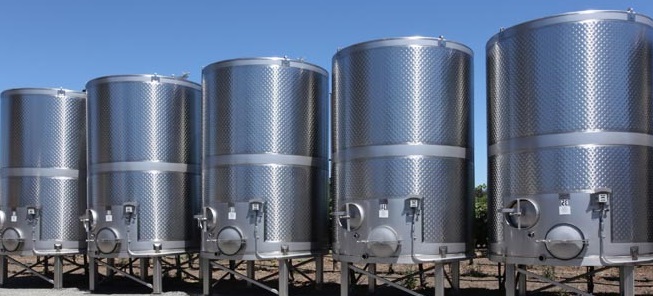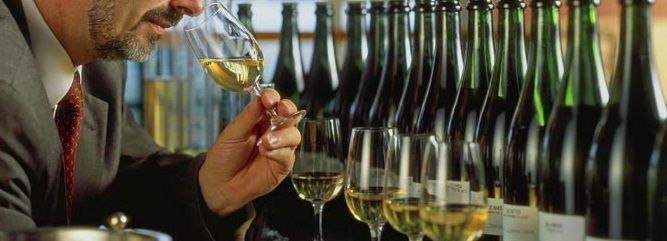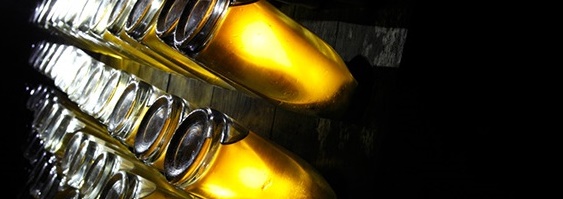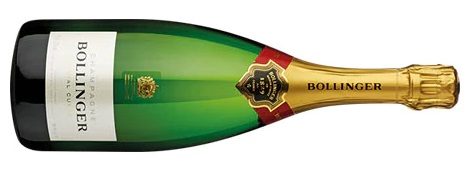Champagne Vinification
Credits: Bourgogne-wines.com
Pressing (Pressurage)Hand picked grape clusters are gently pressed to release the highest quality juice. | |
First FermentationThe juice is transformed into wine (sugar is fermented into alcohol). | |
Blending (Assemblage)Chardonnay, Pinot Noir, and Pinot Meunier wines are blended to create a perfect combination. | |
Second FermentationThe blended wines are fermented in bottles sealed with a metal cap. | |
Riddling (Remuage)The bottles are turned very slowly to sink the sediments. | |
Disgorging (Dégorgement)The top of the bottles are frozen to remove the sediments. | |
DosageA "dosage" of juice/sugar and spirit is added to the bottle. |
Pressing (Pressurage)
Hand picked whole clusters are gently pressed to release the highest quality grape juice. In this process, everything is done to avoid staining the juice.
By gradually increasing the pressure the juice is seperated into different qualities.
Coeur de Cuvée
In Champagne, juice extraction is limited to 2550 litres per 4.000 kg grapes.
The best quality juice is called "Coeur de Cuvée" (Heart of the Vintage).
| Frase | Description | Usage |
| Coeur de Cuvée | The first 2050 litres High quality juice Rich in sugar and acidity |
Top prestige cuvées are made from this |
| Taille de Cuvée | The next 500 litres Inferior to Coeur de Cuvée |
Used in small quantity for fruity and low acid content |
| Rebêche | The rest |
Not used Generally sent to be distilled |
Belons
In Champagne the juice from the pressing is collected in tanks called "belons".
Sulphuring
Addition of sulfur dioxide (SO2) takes place immediately. The rate is from 6 to 10 g/hl depending on the health of the grapes and the must (cuvée or taille).Settling (Débourbage)
Débourbage (de-sludging) is the word for letting the freshly pressed juice settle before fermentation. This also allows for solids (skins and pips) to sink to the bottom for easy removal.
Chaptalisation
Chaptalisation is the process of adding sugar to the must to obtain 11% alcohol after the fermentation.
After settling, the juice is sendt to the winery for the first fermentation.
First Fermentation

Alcoholic fermentation transforms grape juice into wine
Alcoholic Fermentation
This first fermentation transforms the grape juice into wine. Yeasts transform sugar into alcohol. The fermentation process lasts for about two weeks.
Most producers ferment in thermostatically controlled stainless-steel vats (tanks) which gives the purest expression of fruit, while fermentation in oak (barriques) gives more softness and richness.
Malolactic Fermentation
Malolactic fermentation transforms malic acid into lactic acid. This fermentation takes place at the end of the alcoholic fermentation and takes about 4 to 5 weeks. Like all fermentations, it changes the aromas of the wine.
Separation
By pressing different grapes (different varieties, different terroir) separately and fermenting cuvee and taille separately, a whole taste palette of wines are available for the blending.Clarification
Clarification is carried out either by filtration or centrifugation. Stripped of solids, these "clear wines", still listed by year, grape, and cru, are ready for blending.
Blending (Assemblage)

Trying to create a perfect combination
The blending takes place in the winter/spring. Winemakers will taste different types of wine (Red and White) from different years, vineyards (or regions), trying to blend a perfect Champagne combination.
Varieties
Varieties blended in Champagne are:
Chardonnay, Pinot Noir and Pinot Meunier.
| Chardonnay | Adds frechness Citrus and Floral notes |
| Pinot Noir | Adds body and aromas of Red Fruit |
| Pinot Meunier | Adds fruit an roundness |
Non-vintage Champagne
Non-vintage Champagne can be a blend of wines from different years.
Vintage Champagne
Vintage Champagne must be a blend of wines from the same year.
Settling
After blending, the wine ist chilled for cold stabilisation (-4°C). This induces crystallisation of tartaric acid and prevents crystal formation in the product. It may be seeded with tartar crystals for a faster effect. The prosess last for 1 to 4 weeks and leaves the wine perfectly clear.
Second Fermentation

The second fermentation takes place in the bottle
The second fermentation starts with the dry base wine from the first fermentation. This base wine, usually a blend of different vintages and varieties, is high in acidity and low in alcohol (10-11%).
The second fermentation takes place inside the bottle, hermetically sealed with a plastic stopper ("bidule") and a metal cap:
Liqueur de Tirage
The second fermentation is kick-started by adding a "liqueur de tirage". This is a blend of yeast, wine, sugar (20-24 grams/litre), and additives to assist future riddling.
The fermentation lasts from 6 to 8 weeks, while yeast consumes sugar, creates alcohol, and releases the carbon dioxide that create the bubbles.
Maturing on the Side ("Sur Lat")
With the waste and the dead yeast cells still in the bottle, another year of aging contributes to a more complex flavor profile.
The cellar has minimum light, hight humidity, and a constant temperature (12°C/54°F). Champagne wines must spend at least 15 months in the bottle before release, but most Champagne are cellared longer: 2-3 years (non-vintage), 4-10 years (vintage). The greatest Champagne wines can spend several decades maturing in the cellars.
Yeast Autolysis
After fermentation, yeasts form a seediment of "lees" (dead yeast cells) in the bottle. Over time, this sediment breaks down. This is called "Autolysis".
The time (months, years) in contact with the lees, increases the intenisty of the autolitic flavors and creates a richer texture.
Autolitic flavors (secondary aromas) are: Bread, Dough, Toast, Biscuit, Brioch.
Riddling (Remuage)

Riddling takes place with the bottles upside down
Riddling involves turning uptilted bottles very slowly to bring the sediments (dead yeast and waste) down to the bottom (to the cap).
Bottles stored on the side are slowly moved to an upside down position, allowing the sediment to slide gradually to the neck.
Traditionally riddling was done by hand, but today riddling is often automated with a machine (a gyropalette) twisting hundreds of bottles at a time.
Disgorging (Dégorgement)

Disgorgement is about removing the sediment collected around the cork after riddling.
The neck of the bottle is placed in an ice cold solution (between -25 and -30°C), rapidly frozen and then brought upright to remove the cap.
When the cap (the bidole) is removed, the pressure in the bottle (six bars) ejects the frozen sediment out of the bottle.
Yeast and lees can oxygen for many decades (up to 50 years), holding the wine young and fresh. An aging process start after disgorgement. For this reason, the date of disgorgement is on the bottle.
The general rule is: A wine can be kept after disgorgement for as long as it was kept on the lees. The older, the creamier.
Dosage (Liqueur d'Expedition)
Dosage refers to the addition of a "Liqueur d'Expedition" to the top of the bottle to regulate sweetness and profile.
Liqueur d'Expedition is a solution of base wine, sugar and sulfites (preservatives).
To garantee a consistent and recognisable taste, some famous Champagne houses have a secret recipe and they can add cognac, kirsch brandy, edelberry wine, raspberry wine, etc, to the dosage.
A sweeter dosage is necessary to balance the acidity. In colder climates, where grapes stuggle to ripen, the wine is very acidic. The dosage balances the acidity:
| Regulation EC 607/2009 |
Sugar gram/litre |
Calories /glass |
| Brut Nature (Brut Zero) | 0-3 | 3 |
| Extra Brut | 0-6 | 5 |
| Brut | 0-12 | 7 |
| Extra Dry (Extra Sec, Extra Seco) | 12-17 | 10 |
| Dry (Sec, Seco) | 17-32 | 20 |
| Demi (Semi) | 32-50 | 30 |
| Doux (Sweet, Dulce) | 50+ | 30+ |
Resealing
To withstand the inside presure of 6 to 8 bars, Champagne bottles are thicker than normal bottles. In addition, they are corked with a mushroom shaped cork and a wire cage.



Special bottles have biblical names:
| Size | Name |
| 1.5 litre | Magnum |
| 3 litre | Jeroboam (first king of Israel) |
| 4.5 litre | Rehoboam (first king of Judah) |
| 6 litre | Methuselah (died at age 969) |
| 9 litre | Salmanazar (king of Assyria) |
| 12 litre | Balthazar (one of the 3 Magi) |
| 15 litre | Nebuchadnezzar (king of Babylon) |
Labelling
Champagne can be labelled "Premier Cru" and "Grand Cru" to refer to the most favourable terroir.
Bottle Aging
Aging refers to the changes in the wine after bottling. The acidity goes down and the tertiary aromas develop (honey, peach, beeswax, mushroom, spice).
In Champagne, some regions have minimum bottle aging requirements.
Vinification Champagne
Champagne is fermented two times. Once in tanks. Once in the bottle.
Vinification White
White wine is fermented WITHOUT the skins. The grapes are pressed BEFORE fermentation.
Vinification Red
Red wine is fermented WITH the skins. The grapes are pressed AFTER fermentation.